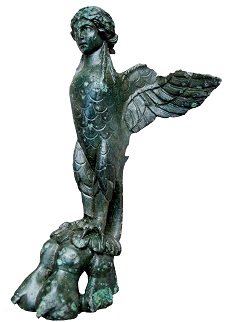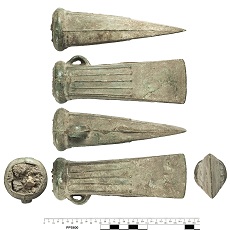The Stuff Of Myth And Legend
Archaeologists from Colchester Archaeological Trust (CAT) have uncovered a rare Roman find at one of our quarries
Archaeologists from Colchester Archaeological Trust (CAT) have uncovered a rare Roman find at Brett Aggregates Brightlingsea quarry near Colchester – a copper-alloy sculpture of a harpy, a mythical monster with the face and torso of a woman and the wings and claws of a bird. The 10cm high sculpture had been broken off a small metal brazier that could have been used to heat a Roman bath-house.
Harpies were believed to snatch earthly evildoers and take them to other mythical beasts known as the Furies, who punished and tormented them.
The archaeological excavation also produced some Roman pottery shards and fragments of roof tile and later Saxon structures, but the harpy is a particularly exciting discovery.
Philip Crummy, Director of CAT, commented: “Certainly the owners of the brazier must have been well off to have been able to afford such a fine piece of equipment.”
Andrew Josephs, archaeological consultant for Brett added: “The find will be analysed along with the results of many hectares of archaeological excavation and the results published. The research will make an important contribution to the archaeology of East Anglia.”
An Axe uncovered at another Brett quarry site
A further interesting discovery was made at another quarry site operated jointly by Brett and Lafarge Tarmac in Surrey. Here a beautiful socketed axe was found in a waterhole during excavations by Oxford Archaeology during preparation for gravel extraction.
The waterhole, which would have provided water for both animals and people, formed part of a more extensive agricultural landscape of fields, tracks and scattered settlements dating to the Late Bronze Age and Early Iron Age periods.
Although this type of axe has been found throughout much of Southern England, the Midlands and South Wales, this example is in exceptionally good condition and, with its decorated finish, is a particularly fine example.
Ken Welsh of Oxford Archaeology said The axe is unlikely to have been lost by accident as it would have been a very valuable object. Axes like this one are often found in watery places and it was probably deliberately placed in the waterhole, perhaps as an offering to the gods.”
Andrew Josephs added “The axe will now be conserved for future generations and further analysis undertaken to ensure that we understand as much as possible of this beautiful object.”
“It is always exciting when ancient artefacts are uncovered on our sites but to find two such exceptional pieces is quite extraordinary,” says Oliver Brown, Development Director of Brett Aggregates. “We look forward to learning more about the harpy and the axe and what they can tell us about local history.”






